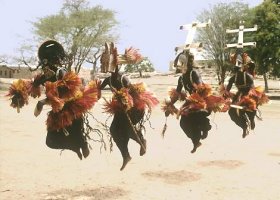
 In
southern Mali, West Africa, lives a tribe whose members believe they
were visited some 3000 years ago by extraterrestrial beings from
another star system. From these beings, they would have had received
advanced knowledge about a certain star called Sirius B, which is
situated within the star cluster of Pleiades and could not be seen with
only the naked eye.
In
southern Mali, West Africa, lives a tribe whose members believe they
were visited some 3000 years ago by extraterrestrial beings from
another star system. From these beings, they would have had received
advanced knowledge about a certain star called Sirius B, which is
situated within the star cluster of Pleiades and could not be seen with
only the naked eye.
Members of the Dogon tribe (see image on the right) already knew about
Sirius B long before western science rediscovered the star system.
Their religious tradition, dating back to their Egyptian roots, was
later imparted through Greek migratory patterns and the name Sirius was
given by the ancient Greeks. They shared their knowledge with French
anthropologists before its discovery by the western world in the year
1862, as what looked like a white dwarf: a very small star with an
incredible mass and density. Its had first been photographed in the
year 1970, but western science already knew of its existence.
This knowledge
would have been revealed since the year 1946 to the anthroplogists
Marcel Griaule and Germain Dieterlen by four Dogon "priests"
who would have been initiates of their own esoteric knowlegde.
According to one of these priests named Ogotemmelli, at that time,
only 15 percent of the tribe's members would have been exposed
to this "secret knowlegde".
In the year 1991 the
Dutch anthropologist Wouter (Walter) van Beek travelled to Mali to
research the matter. He however did not find a single trace of the
detailed story about Sirius B. This could mean that this knowledge
eventually became lost or that they didn't tell him (let us not
forget it was supposed to be "secret knowledge"), or that
the story of Griaule and Dieterlen was incorrect. The anthropologists
M. Griaule and G. Dieterlen shared their information with Robert
Temple, who accordingly wrote the book: "The Sirius Mystery"
(1975). It is assumed by some that this information became popular
because of this book, but other authors already mentioned this
information before, including Peter Kolosimo in his book: "Non e
terrestre" (1968), were he referred to the information from
Prof. Jean Servier, ethnography teacher at Montpellier.
According to the story, the Dogon named the star
Sirius: "Pô Tolo". "Pô" would be the word for the smallest planets they
knew. It would be the most heavy star because all earth on that star
was transformed into an unbelievably heavy metal called "Sagolu" (or
"Sagala"). It was claimed that the star was white, would have an orbit
of its own that was elliptical and had Sirius A as its focus.
Scientific evidence actually confirmed these claims. Furthermore, they
claimed the sidereal time was 50 years, while scientists discovered a
sidereal time of 50.04 years with variations of 0.09 years. The Dogon
believed the star travelled around her own orbit, which is also
scientifically correct.
They also would have said there is a third star in this system
they call "Emma Ya", which is orbited by a planet. Although
we do not know whether or not this star and planet exists, in
the year 1995 the French researchers Daniel Benest and J.L. Duvent
suggested the possibility of the existence of a third star with the
system of Sirius The Dogon also would have known that Saturn has
rings, that Jupiter has four moons and that planets orbited around
the sun. The tribe woud have made use of four calendars which are
based on the sun, the moon, Sirius B and Venus.
According to
Griaule al this knowledge would have been received by amphibious
beings who were known as “Nommos”, who would have come from the
star system of Sirius. He described these beings as fish-like, shaped
as a kind of dolphin. They arrived on planet Earth in a space ship
with three triangular “paws”. As soon as they landed, they
created water to get into it. They could live as well on land as in
water. Some of them stayed in a bigger space ship which orbited in
the atmosphere. The word “Nommos” would have been derived from
the Dogon word “to drink”, and they also would have called them
the "Masters of the Water”, the "Monitors”, and the
"Mentors”.
According to the research of Verbeek,
Griaule would have gone to far with his conclusions, and that he
would have presented his own outrageous assumptions as facts. He
even believes that it was Griaule himself who initially told the
tribe about Sirius B. According to Verbeek there was also nothing
known about so-called "secret" information which was only
known by a small number of its inhabitants This however does not mean
that this knowledge couldn't have existed because Verbeek's research
was conducted some 35-45 years later. The research mentions the
Nommos as "water spirits", where there is no mention about
spaceships and such like Griaule described. Anyway, it would be
highly unlikely that a primitive tribe like the Dogon would have been
talking specifically about spaceships.
This however doesn't
rule out the possibility that these spirits couldn't have been of
extraterrestrial origin, because according to the myth they would
have descended from the heavens, which is very similar to the
previously mentioned Mesopotamian/Biblical story from Genesis about
the angels who descended to the Earth. (See the chapter: "The
Sons of God and the Daughters of Men".) Their mythology
seems to be steeped by influences from a multitude of
Mesopotamian/Biblical stories (Adam and Eve, Moses) but with
substantive differences. Some researchers believe that the Dogon
tribe were a division of the people from the early ancient
Egyptians.



